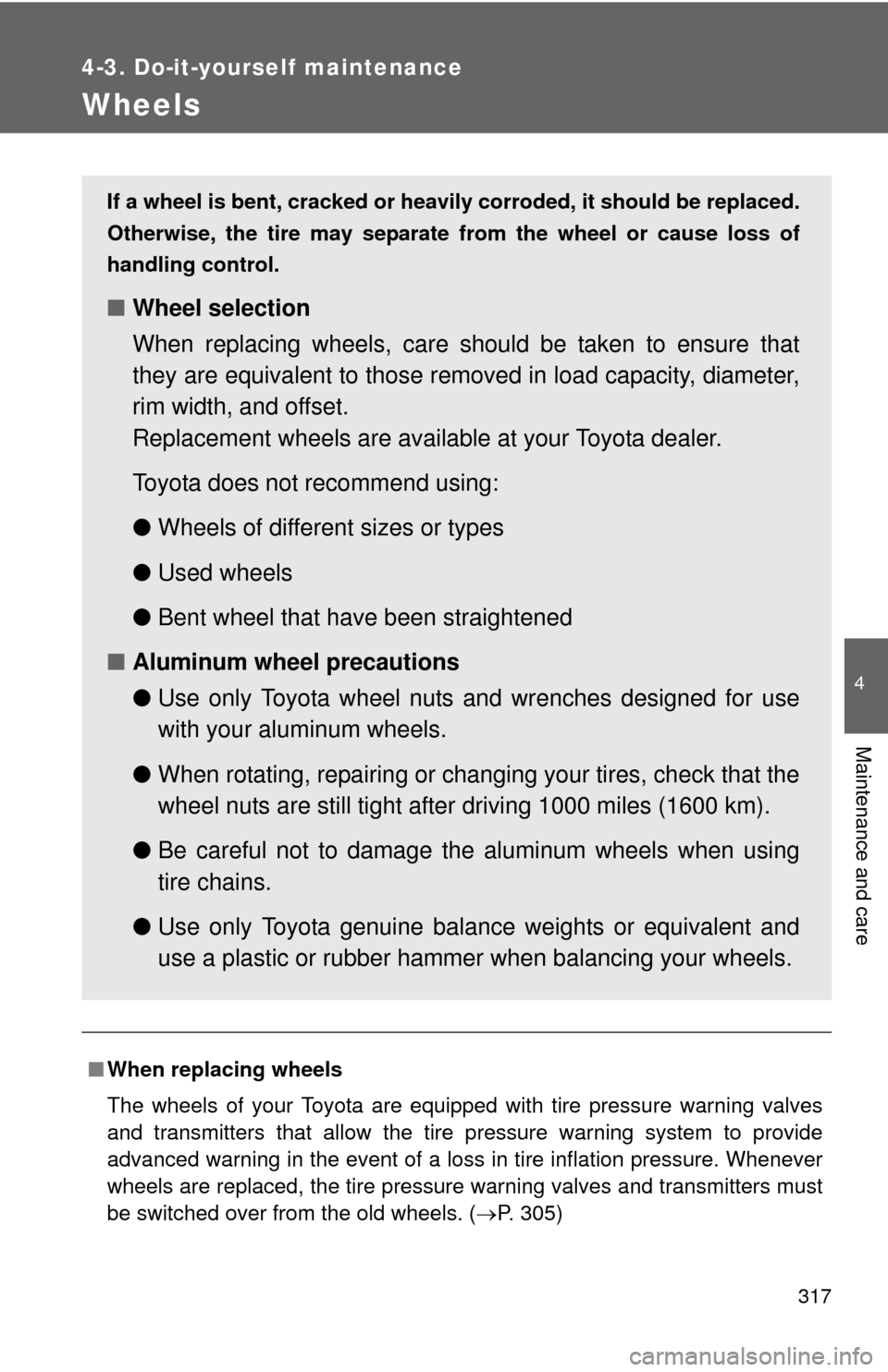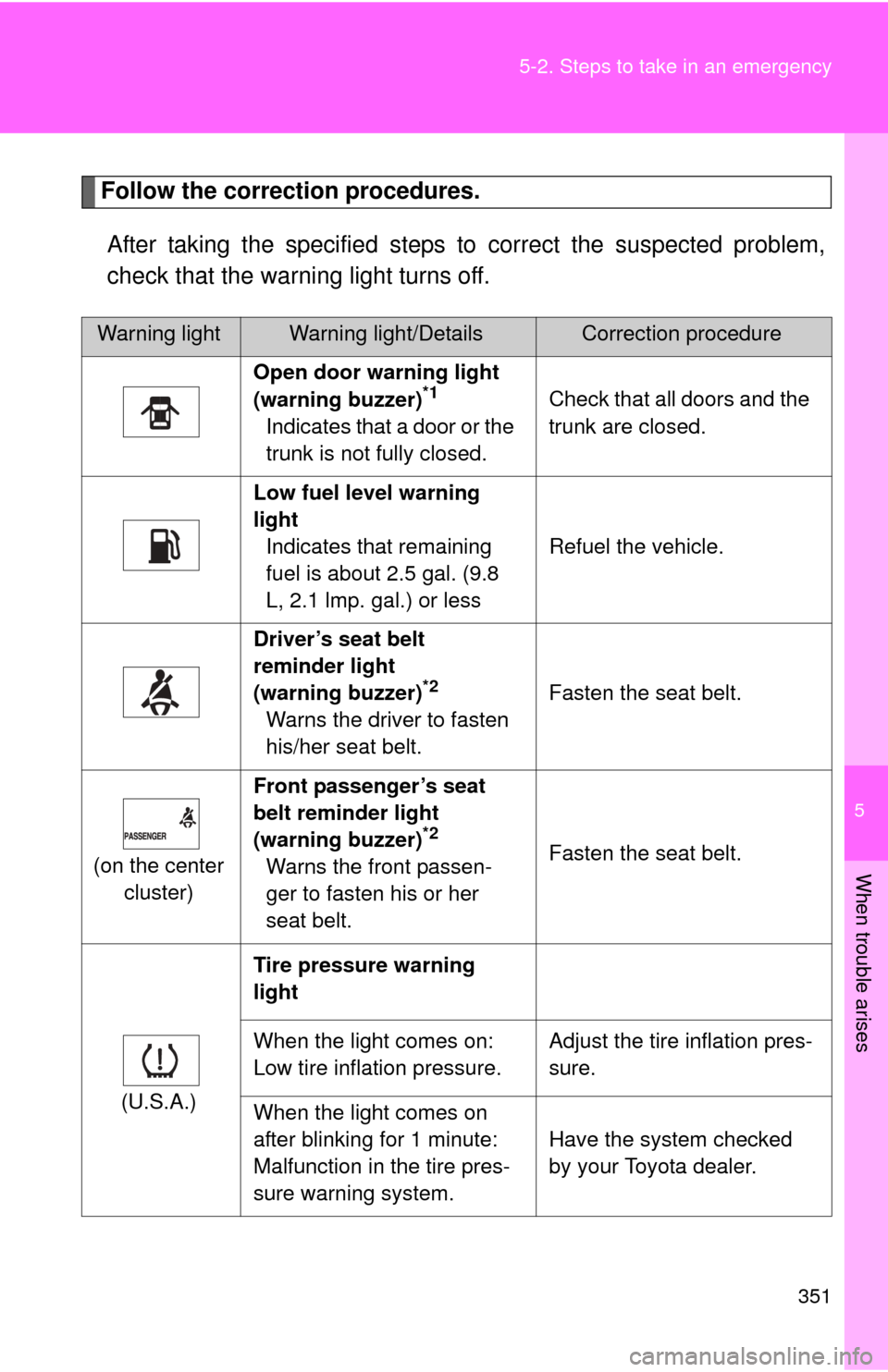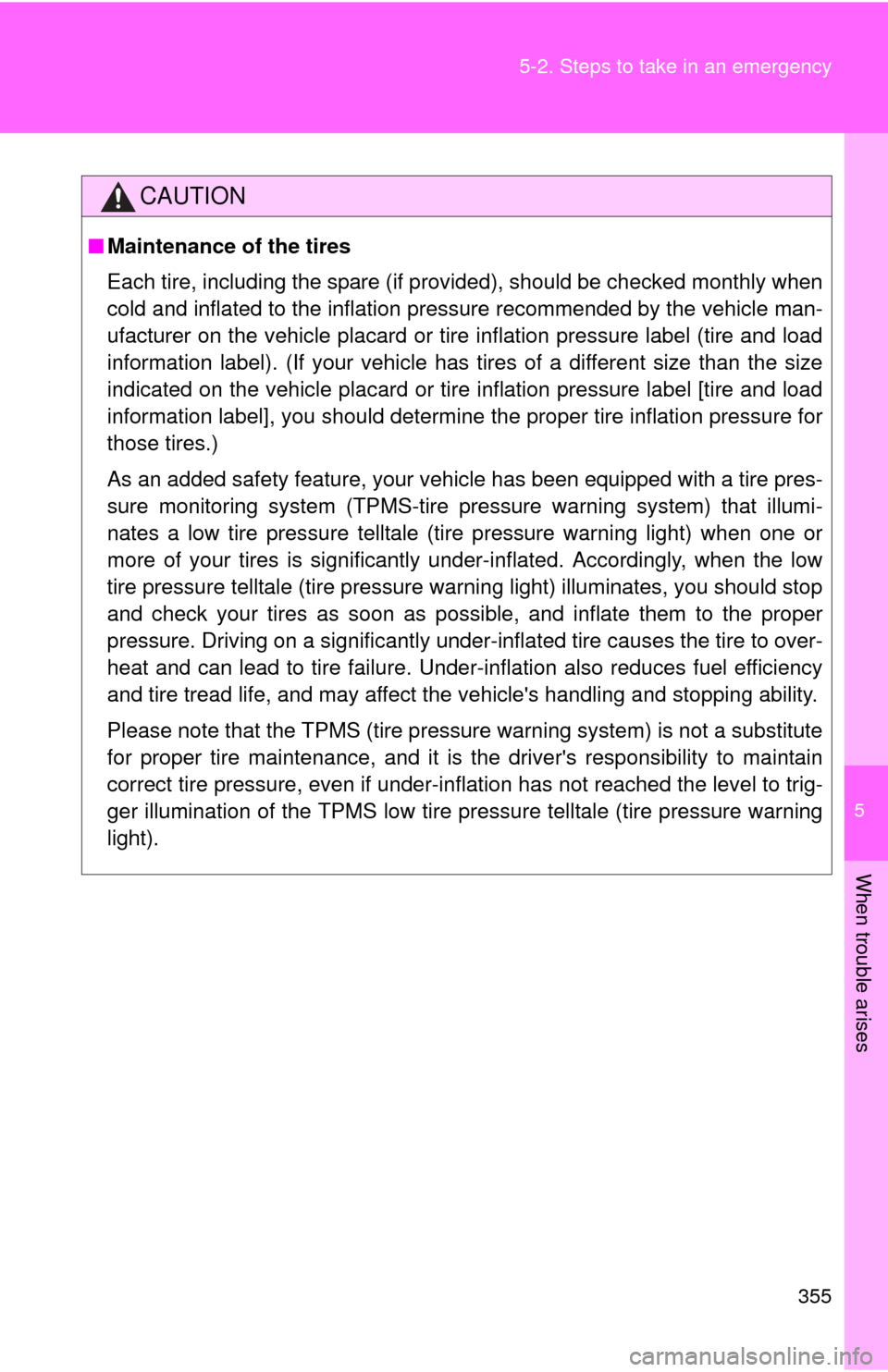Page 317 of 440

317
4-3. Do-it-yourself maintenance
4
Maintenance and care
Wheels
■When replacing wheels
The wheels of your Toyota are equipped with tire pressure warning valves
and transmitters that allow the tire pressure warning system to provide
advanced warning in the event of a loss in tire inflation pressure. Whenever
wheels are replaced, the tire pressure warning valves and transmitters must
be switched over from the old wheels. (P. 305)
If a wheel is bent, cracked or heavily corroded, it should be replaced.
Otherwise, the tire may separat e from the wheel or cause loss of
handling control.
■ Wheel selection
When replacing wheels, care should be taken to ensure that
they are equivalent to those removed in load capacity, diameter,
rim width, and offset.
Replacement wheels are available at your Toyota dealer.
Toyota does not recommend using:
●Wheels of different sizes or types
● Used wheels
● Bent wheel that have been straightened
■ Aluminum wheel precautions
●Use only Toyota wheel nuts and wrenches designed for use
with your aluminum wheels.
● When rotating, repairing or changing your tires, check that the
wheel nuts are still tight after driving 1000 miles (1600 km).
● Be careful not to damage the aluminum wheels when using
tire chains.
● Use only Toyota genuine bal ance weights or equivalent and
use a plastic or rubber hammer when balancing your wheels.
Page 334 of 440

334 4-3. Do-it-yourself maintenance
25 IGN10 AMultiport fuel injection system/
sequential multiport fuel injection
system, SRS airbag system, steer-
ing lock system, front passenger
occupant classification system,
smart key system, electronic throt-
tle control system
26 GAUGE NO.2 7.5 A Gauges and meters, clock
27 ECU-ACC 7.5 A Clock, main body ECU, shift lock
control system, outside rear view
mirrors, smart key system, starting
system
28 CIG 20 A No circuit
29 PWR OUTLET 20 A Power outlet
30 RADIO NO.2 7.5 A Audio system, navigation system
31 MIR HTR 10 A Outside rear view mirror defoggers
32 POWER 30 A Power windows
33 P/SEAT 30 A Power seat
■ After a fuse is replaced
●If the lights do not turn on even after the fuse has been replaced, a bulb
may need replacing. ( P. 336)
● If the replaced fuse blows again, have the vehicle inspected by your
Toyota dealer.
■ If there is an overload in the circuits
The fuses are designed to blow before the entire wiring harness is damaged.
FuseAmpereCircuit
Page 345 of 440
5
When trouble arises
345
5-1. Essential information
If you think something is wrong
If you notice any of the following symptoms, your vehicle probably
needs adjustment or repair. Contact your Toyota dealer as soon as
possible.
■ Visible symptoms
●Fluid leaks under the vehicle
(Water dripping from the air cond itioning after use is normal.)
● Flat-looking tires or uneven tire wear
● Engine coolant temperature g auge needle continually points
higher than normal
■ Audible symptoms
●Changes in exhaust sound
● Excessive tire squeal when cornering
● Strange noises related to the suspension system
● Pinging or other noises related to the hybrid system
■ Operational symptoms
●Engine missing, stumbling or running rough
● Appreciable loss of power
● Vehicle pulls heavily to one side when braking
● Vehicle pulls heavily to one side when driving on a level road
● Loss of brake effectiveness, s pongy feeling, pedal almost
touches the floor
Page 351 of 440

5
When trouble arises
351
5-2. Steps to take in an emergency
Follow the correction procedures.
After taking the specified steps to correct the suspected problem,
check that the warning light turns off.
Warning lightWarning light/DetailsCorrection procedure
Open door warning light
(warning buzzer)
*1
Indicates that a door or the
trunk is not fully closed. Check that all doors and the
trunk are closed.
Low fuel level warning
light Indicates that remaining
fuel is about 2.5 gal. (9.8
L, 2.1 lmp. gal.) or less Refuel the vehicle.
Driver’s seat belt
reminder light
(warning buzzer)
*2
Warns the driver to fasten
his/her seat belt. Fasten the seat belt.
(on the center cluster) Front passenger’s seat
belt reminder light
(warning buzzer)
*2
Warns the front passen-
ger to fasten his or her
seat belt.
Fasten the seat belt.
(U.S.A.) Tire pressure warning
light
When the light comes on:
Low tire inflation pressure.
Adjust the tire inflation pres-
sure.
When the light comes on
after blinking for 1 minute:
Malfunction in the tire pres-
sure warning system. Have the system checked
by your Toyota dealer.
Page 353 of 440

5
When trouble arises
353
5-2. Steps to take in an emergency
■
When a tires is replaced with a spare tire
The compact spare tire is not equipped with the tire pressure warning valve
and transmitter. If a tire goes flat, the tire pressure warning light will not turn
off even though the flat tire is replaced with the spare tire. Replace the spare
tire with the repaired tire and adjust the proper tire inflation pressure.
The tire pressure warning light will turn off after a few minutes.
■ If the tire pressure warning system is inoperative
The tire pressure warning system may become inoperative in the following
conditions:
(When the condition becomes normal, the system will work properly.)
●If tires not equipped with tire pressure warning valves and transmitters
are used.
● If the ID code on the tire pressure warning valves and transmitters is not
registered in the tire pressure warning computer.
● If electronic devices or facilities using similar radio wave frequencies are
nearby.
● If a radio set at similar frequencies is in use in the vehicle.
● If there is a lot of snow or ice on the vehicle, in particular around the
wheels or wheel housings.
● If non-genuine Toyota wheels are used. (Even if you use Toyota wheels,
the tire pressure warning system may not work properly with some types
of tires.)
● If tire chains are used.
● If the tire inflation pressure is 73 psi (500 kPa, 5.1 kgf/cm
2 or bar) or
higher
■ If the tire pressure warning light comes on after blinking frequently for
1 minute
If the tire pressure warning light comes on after blinking frequently for 1
minute when the “POWER” switch is turned to ON mode, have it checked by
your Toyota dealer.
Page 354 of 440

354 5-2. Steps to take in an emergency
■Customization
The vehicle speed linked seat belt reminder buzzer can be disabled.
(P. 421)
However, Toyota recommends that the seat belt reminder buzzer be opera-
tional to alert the driver and front passenger that the seat belts are not fas-
tened.
CAUTION
■ If the tire pressure warning light comes on
Be sure to observe the following precautions. Failure to do so could cause
loss of vehicle control and result in death or serious injury.
●Stop your vehicle in a safe place as soon as possible. Adjust the tire infla-
tion pressure immediately.
● If the tire pressure warning light comes on even after tire inflation pressure
adjustment, it is probable that you have a flat tire. Check the tires. If the
tire is flat, change to the spare tire and have the flat tire repaired by the
nearest Toyota dealer.
● Avoid abrupt maneuvering and braking. If the vehicle tires deteriorate, you
could lose control of the steering wheel or the brakes.
■ If a blowout or sudden air leakage should occur
The tire pressure warning system may not activate immediately.
Page 355 of 440

5
When trouble arises
355
5-2. Steps to take in an emergency
CAUTION
■
Maintenance of the tires
Each tire, including the spare (if provided), should be checked monthly when
cold and inflated to the inflation pressure recommended by the vehicle man-
ufacturer on the vehicle placard or tire inflation pressure label (tire and load
information label). (If your vehicle has tires of a different size than the size
indicated on the vehicle placard or tire inflation pressure label [tire and load
information label], you should determine the proper tire inflation pressure for
those tires.)
As an added safety feature, your vehicle has been equipped with a tire pres-
sure monitoring system (TPMS-tire pressure warning system) that illumi-
nates a low tire pressure telltale (tire pressure warning light) when one or
more of your tires is significantly under-inflated. Accordingly, when the low
tire pressure telltale (tire pressure warning light) illuminates, you should stop
and check your tires as soon as possible, and inflate them to the proper
pressure. Driving on a significantly under-inflated tire causes the tire to over-
heat and can lead to tire failure. Under-inflation also reduces fuel efficiency
and tire tread life, and may affect the vehicle's handling and stopping ability.
Please note that the TPMS (tire pressure warning system) is not a substitute
for proper tire maintenance, and it is the driver's responsibility to maintain
correct tire pressure, even if under-inflation has not reached the level to trig-
ger illumination of the TPMS low tire pressure telltale (tire pressure warning
light).
Page 356 of 440

356 5-2. Steps to take in an emergency
CAUTION
Your vehicle has also been equipped with a TPMS (tire pressure warning
system) malfunction indicator to indicate when the system is not operating
properly. The TPMS (tire pressure warning system) malfunction indicator is
combined with the low tire pressure telltale (tire pressure warning light).
When the system detects a malfunction, the telltale will flash for approxi-
mately one minute and then remain continuously illuminated. This sequence
will continue upon subsequent vehicle start-ups as long as the malfunction
exists. When the malfunction indicator is illuminated, the system may not be
able to detect or signal low tire pressure as intended.
TPMS (tire pressure warning system) malfunction may occur for a variety of
reasons, including the installation of replacement or alternate tires or wheels
on the vehicle that prevent the TPMS (tire pressure warning system) from
functioning properly. Always check the TPMS (tire pressure warning system)
malfunction telltale after replacing one or more tires or wheels on your vehi-
cle to ensure that the replacement or alternate tires and wheels allow the
TPMS (tire pressure warning system) to continue to function properly.
NOTICE
■Precaution when installing a different tire
When a tire of a different specification or maker is installed, the tire pressure
warning system may not operate properly.